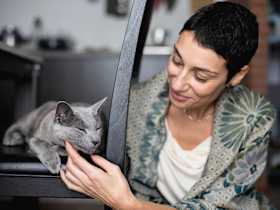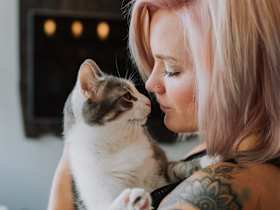How to Tell if Your Cat Loves You
Here are all the subtle (and not-so-subtle) ways cats show affection and love for their humans.
Here are all the subtle (and not-so-subtle) ways cats show affection and love for their humans.
by Katie Koschalk, | June 5, 2025

jamie grill atlas / Stocksy
Every cat parent has probably wondered at some point if their cat actually loves them. Unlike dogs, cats don’t typically greet us with wagging tails or slobbery kisses, but that doesn’t mean they aren’t deeply bonded with their humans. In fact, research suggests that cats are capable of forming strong emotional attachments to their caregivers.
Feline affection might be more subtle and quirky, but once you know what to look for, you’ll start to notice the many ways your cat is quietly saying “I love you.”
In this article, we’ll explore the sweet, surprising ways cats show their love, how you can return the favor, and how adopting a cat can lead to one of the most rewarding relationships of your life.

Stocksy
Cats are often thought of as emotionally distant or only affectionate when they want something, but that’s a common misconception. In reality, many cats form deep, lasting bonds with their humans.
So, how can you tell if your cat loves you? According to Joey Lusvardi, a certified cat behavior consultant and founder of Class Act Cats, the answer lies in body language. He says cats show affection toward humans using the same signals they’d use with fellow felines they trust and care about.
That said, there are a couple of important caveats. First, most cats need time to build trust. “Cats require a bit more reassurance that you’re safe than dogs do, but cats can develop deep affection towards us,” he says.
Second, early experiences matter. Kittens who are gently handled and regularly socialized with people are more likely to grow into affectionate, people-oriented adult cats.
Ready to decode your cat’s feelings? Here are some of the most common ways cats show their love.
Often called “making biscuits” or “making dough,” this rhythmic paw-pushing behavior is a throwback to kittenhood. When your cat kneads on you, it means they feel safe, content, and connected.
Rubbing against you is your cat’s way of leaving their scent on you, Lusvardi says. While some interpret it as claiming you, it’s actually a form of scent mixing — something cats do with others they feel positively about and want to be close to, he explains.
While cats can purr for a few different reasons, a calm, steady purr when they’re near you is usually a sign of happiness and affection.
A cat’s version of a kiss, slow blinks are a sign of trust and love. If your cat blinks slowly at you, try slow blinking back — it’s a great way to say “I love you” in cat language.
If your cat tries to groom you, whether they’re licking your hand, arm, or hair, take it as a big compliment. In the feline world, grooming each other, known as allogrooming, is a bonding behavior between cats who trust one another. So when your cat extends this habit to you, it’s their way of saying you’re family.
If your cat rushes to the door when you come home or gives you a little chirp or headbutt in greeting, that’s love. They’re happy to see you.
Whether they’re following you from room to room or keeping you company in the bathroom, a cat who chooses to stay near you is showing they value you and enjoy your presence.
It may not always be pleasant, but bringing you a toy (or a less desirable offering from outside) is a sign that your cat considers you part of their inner circle.
A cat’s belly is one of the most vulnerable parts of their body. If they flop over and expose it to you, it’s a major sign of trust (even if they don’t always want it touched).
Cats typically don’t meow at each other, but they do meow at humans. If your cat “talks” to you, it’s their way of starting a conversation and trying to connect. Think of it as their version of saying, “Hey, pay attention to me.”
Also called “bunting,” this sweet gesture involves your cat rubbing their head against you to leave their scent. It’s a way of marking you as part of their inner circle and is one of the clearest signs of love, trust, and affection.
“Cats that spend time in close proximity to you, even if they don’t want to be petted, are showing a lot of trust and a desire to be close to you,” Lusvardi says. “Think of it as being an equivalent of having a friend who comes over just to hang out and watch TV with you: Chances are you wouldn’t want to be around them if you don’t like them.”
This is especially true when cats sleep near you, because cats are most vulnerable when they sleep. If your cat chooses to nap next to you, or better yet, on you, that’s a huge sign of trust.

Love is a two-way street. Showing your cat love is an important part of keeping them happy and secure. Here are some ways to show your cat how much they mean to you.
Regular playtime helps burn energy, reduce stress, and reinforce your connection. Use wand toys to tap into their natural hunting instincts. Aim for one or two 10-minute play sessions daily.
Cats may not understand what you’re saying, but they definitely pick up on tone and familiar sounds. Chatting with your cat in a calm, gentle voice — even if it’s that slightly ridiculous “cat voice” most of us end up using — can help build familiarity, trust, and a stronger bond.
“Respect your cat as a living, independent being that has preferences, needs, and wants,” Lusvardi says. “Cats aren’t objects, and they won’t always want to be around you or be petted.”
Understanding when your cat wants attention (and when they don’t) is a powerful form of respect. Not forcing interaction when they’re overstimulated or want to be alone helps build trust over time.
Cats feel most secure in spaces that are calm, predictable, and full of opportunities to explore. Offer cozy hiding spots, vertical spaces like cat trees, and puzzle toys to help them feel secure and keep their minds engaged.
And don’t forget to cat-proof your house. Your cat might not realize the effort you’ve put in, but creating a safe, secure space is one of the most meaningful ways to show you care.
Many cats enjoy being gently groomed. It’s a great way to reduce shedding, prevent tangles, and strengthen the bond between you and your cat.
Offering a healthy treat or praise when they do something good encourages desired behavior and builds a strong bond.
Cats are creatures of habit. Regular feeding times, routines, and rituals (such as bedtime cuddles or morning greetings) create a sense of stability, comfort, and trust.
It may not seem glamorous, but keeping the litter box clean is a meaningful way to show your cat you care. A tidy box supports their comfort, reduces stress, and can help prevent unwanted behaviors (like doing their business elsewhere).
Cats may not understand love like humans do, but they recognize affection through your tone, care, and attention. When you treat them kindly and consistently, they associate you with safety, comfort, and companionship.
Bonding can take days to months, depending on the cat’s personality and past. Social cats may warm up quickly, while shy or rescued cats might need more time. Patience, routine, and gentle interaction help build trust and connection.
Kittens knead their mother’s belly to help stimulate milk flow. This comforting behavior often carries into adulthood. If your cat kneads on you, it’s a strong sign they trust you and feel relaxed in your presence.
If you’re ready for a long-term commitment and can provide a safe, loving home, adopting a cat can be incredibly rewarding. Cats offer companionship, personality, and love. Plus, you’ll be giving a deserving animal a second chance and helping reduce pet overpopulation.
Blackwell, Emily. “How to Tell If Your Cat Loves You, according to Science.” Scientific American, 5 Oct. 2022, www.scientificamerican.com/article/how-to-tell-if-your-cat-loves-you-according-to-science.
Piore, Adam. “You Believe Your Cat Loves You. Now Science Has Proof.” Newsweek, 13 Sept. 2023, www.newsweek.com/2023/09/22/you-believe-your-cat-loves-you-now-science-has-proof-1826499.html.
Vitale, Kristyn R., et al. “Attachment Bonds between Domestic Cats and Humans.” Current Biology, vol. 29, no. 18, 23 Sept. 2019, pp. R864–R865, www.cell.com/current-biology/fulltext/S0960-9822(19)31086-3.

Katie Koschalk is a freelance writer based in Northern California. Fusing her love and knowledge of animals with her journalism degree and years of professional writing, Katie is dedicated to improving the lives of pets and their caretakers by sharing helpful and accurate information. When she’s not at her desk, you can find her exploring trails with her Aussie, Hunter, cooking plant-based meals, and talking to her two cats, Jax and Sadie, in really ridiculous voices.

Adoption Advice

Adoption Advice

Adoption Advice

Shelters & Rescue
It's not just a cute fad — kitten yoga is also an effective way to help kitties find their humans.

Adoption Advice
Here’s a primer on the cultural history of black cats, why they look the way they do, and how to celebrate Black Cat Awareness Month.

Adoption Advice
Sure, this ongoing condition requires care. But for patient and committed pet parents, these cats can make great companions.

Breed Info
These devoted cats are basically love wrapped in fur.


Breed Info
Black cats are just as talkative, affectionate, curious, and loyal as their multicolored counterparts — not to mention gorgeous.